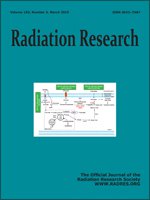Studies of gene expression have proved important in defining the molecular mechanisms of radiation action and identifying biomarkers of ionizing radiation exposure and susceptibility. The full transcriptional response to radiation is very complex since it also involves epigenetic mechanisms triggered by radiation exposure such as modifications of expression of noncoding RNA such as microRNAs (miRNAs) and long noncoding RNAs (lncRNAs) that have not been fully characterized. To improve our understanding of the transcriptional response to radiation, we simultaneously monitored the expression of ten protein-coding genes, as well as 19 miRNAs and 3 lncRNAs in a time- and dose-dependent manner in stimulated human T lymphocytes obtained from two healthy donors (C1 and C2) and one patient with ataxia telangiectasia (AT), which is a well characterized radiosensitivity disorder. After 2 Gy X irradiation, expression levels were monitored at time points ranging from 15 min up to 24 h postirradiation. The majority of genes investigated responded rapidly to radiation exposure, with the peak up-regulation (CDKN1A, SESN1, ATF3, MDM2, PUMA and GADD45A) or down-regulation (CCNB1) occurring 2–3 h postirradiation, while DDB2, FDXR and CCNG1 responded with slower kinetics reaching a peak of expression between 5 and 24 h. A significant modification of expression after radiation exposure was observed for miR-34a-5p and miR-182-5p, with an up-regulation occurring at late time points reaching two to threefold at 24 h. Differences between two donors in miR-182-5p response to radiation were detected: for C2, up-regulation reached a plateau-phase around 5 Gy, while for C1, up-regulation was at its maximum around 3 Gy and then decreased at higher doses. Among the three lncRNAs studied, TP53TG1 demonstrated a weak up-regulation, reaching a maximum of 1.5-fold at 24 h after radiation exposure. Conversely, FAS-AS1 was up-regulated up to fivefold by 5 Gy irradiation. Our results indicate that expression of the majority of protein-coding genes allows discrimination of the AT from healthy donors when analyzed at 2 h. However, differences in expression between AT and healthy donors are no longer detectable 24 h postirradiation although, interestingly, linear dose responses for some of the genes studied are obtained at this time point. Furthermore, our study shows that miRNAs miR-34a-5p and miR-182-5p are responsive to radiation exposure in a dose- and time-dependent manner. Additionally, to the best of our knowledge, this is the first study to report that FAS-AS1 lncRNA is up-regulated by radiation exposure in an ATM-dependent fashion in human T lymphocytes.
How to translate text using browser tools
4 March 2015
Time, Dose and Ataxia Telangiectasia Mutated (ATM) Status Dependency of Coding and Noncoding RNA Expression after Ionizing Radiation Exposure
S. Kabacik,
G. Manning,
C. Raffy,
S. Bouffler,
C. Badie





